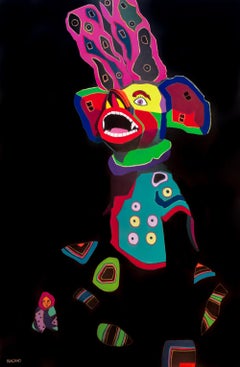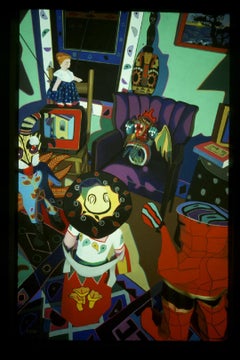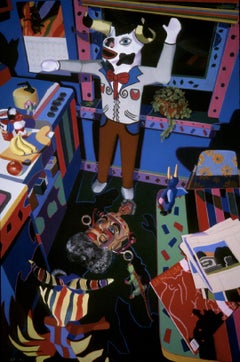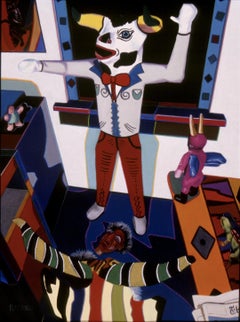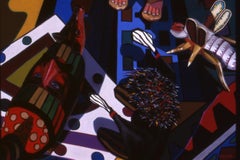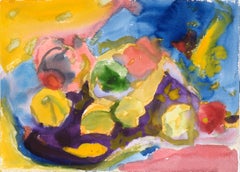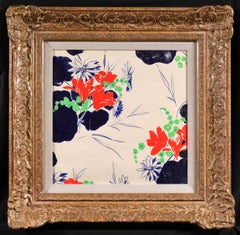Barbara Rachko Art
to
5
5
3
1
Impresario
By Barbara Rachko
Located in Santa Monica, CA
Original Soft Pastel on Sandpaper
Category
21st Century and Contemporary Abstract Expressionist Barbara Rachko Art
Materials
Pastel
Practical Advice on Waiting, bright colors, domestic, Latin objects
By Barbara Rachko
Located in Brooklyn, NY
Works
Her pastel-on-sandpaper series, "Domestic Threats" and "Black Paintings", both use cultural objects as surrogates for human beings acting in mysterious, highly charged narratives.[9][10]
Rachko also has created a series of photographs entitled "Gods and Monsters".[11] In these chromogenic prints, she is "painting with a camera," creating variations that free the camera from being a mechanical recording device of what lies before it. She prints all of these images by hand.
The earlier "Domestic Threats" pastel-on-sandpaper paintings used her West Village apartment or her 1932 Sears house in Virginia as a backdrop. The "Black Paintings" series grew directly from "Domestic Threats". In the "Black Paintings," the figures (actors) take center stage. All background details, furniture, rugs, etc. have been eliminated and replaced by intense dark black pastel. Each painting takes months to complete as she slowly builds up as many as 30 layers of soft pastel.
Her long-standing fascination with traditional masks progressed in the spring of 2017 when she visited the National Museum of Ethnography and Folklore in La Paz, Bolivia where one exhibition included more than fifty festival masks. The resulting series is entitled “Bolivianos”.[12]
She has also written an e-book, From Pilot to Painter[13] and writes a regular blog, Barbara Rachko...
Category
Early 2000s Fauvist Barbara Rachko Art
Materials
Pastel
He Was So in Need of Botany, bright colors, domestic, Latin objects
By Barbara Rachko
Located in Brooklyn, NY
Price and size includes frames (maple wood with white mats).
Artwork 58" x 38"
Her pastel-on-sandpaper series, "Domestic Threats" and "Black Paintings", both use cultural objects as surrogates for human beings acting in mysterious, highly charged narratives.[9][10]
Rachko also has created a series of photographs entitled "Gods and Monsters".[11] In these chromogenic prints, she is "painting with a camera," creating variations that free the camera from being a mechanical recording device of what lies before it. She prints all of these images by hand.
The earlier "Domestic Threats" pastel-on-sandpaper paintings used her West Village apartment or her 1932 Sears house in Virginia as a backdrop. The "Black Paintings" series grew directly from "Domestic Threats". In the "Black Paintings," the figures (actors) take center stage. All background details, furniture, rugs, etc. have been eliminated and replaced by intense dark black pastel. Each painting takes months to complete as she slowly builds up as many as 30 layers of soft pastel.
Her long-standing fascination with traditional masks progressed in the spring of 2017 when she visited the National Museum of Ethnography and Folklore in La Paz, Bolivia where one exhibition included more than fifty festival masks. The resulting series is entitled “Bolivianos”.[12]
She has also written an e-book, From Pilot to Painter[13] and writes a regular blog, Barbara Rachko...
Category
Early 2000s Fauvist Barbara Rachko Art
Materials
Pastel
Scene Fourteen: Kitchen, bright colors, domestic, Latin objects
By Barbara Rachko
Located in Brooklyn, NY
Price and size includes frames (maple wood with white mats).
Artwork 58" x 38"
Her pastel-on-sandpaper series, "Domestic Threats" and "Black Paintings", both use cultural objects as surrogates for human beings acting in mysterious, highly charged narratives.[9][10]
Rachko also has created a series of photographs entitled "Gods and Monsters".[11] In these chromogenic prints, she is "painting with a camera," creating variations that free the camera from being a mechanical recording device of what lies before it. She prints all of these images by hand.
The earlier "Domestic Threats" pastel-on-sandpaper paintings used her West Village apartment or her 1932 Sears house in Virginia as a backdrop. The "Black Paintings" series grew directly from "Domestic Threats". In the "Black Paintings," the figures (actors) take center stage. All background details, furniture, rugs, etc. have been eliminated and replaced by intense dark black pastel. Each painting takes months to complete as she slowly builds up as many as 30 layers of soft pastel.
Her long-standing fascination with traditional masks progressed in the spring of 2017 when she visited the National Museum of Ethnography and Folklore in La Paz, Bolivia where one exhibition included more than fifty festival masks. The resulting series is entitled “Bolivianos”.[12]
She has also written an e-book, From Pilot to Painter[13] and writes a regular blog, Barbara Rachko...
Category
2010s Folk Art Barbara Rachko Art
Materials
Pastel
Scene Twentyone: Living Room bright colors, domestic, Latin objects
By Barbara Rachko
Located in Brooklyn, NY
Price and size includes frames (maple wood with white mats).
Artwork 20" x 26"
Her pastel-on-sandpaper series, "Domestic Threats" and "Black Paintings", both use cultural objects as surrogates for human beings acting in mysterious, highly charged narratives.[9][10]
Rachko also has created a series of photographs entitled "Gods and Monsters".[11] In these chromogenic prints, she is "painting with a camera," creating variations that free the camera from being a mechanical recording device of what lies before it. She prints all of these images by hand.
The earlier "Domestic Threats" pastel-on-sandpaper paintings used her West Village apartment or her 1932 Sears house in Virginia as a backdrop. The "Black Paintings" series grew directly from "Domestic Threats". In the "Black Paintings," the figures (actors) take center stage. All background details, furniture, rugs, etc. have been eliminated and replaced by intense dark black pastel. Each painting takes months to complete as she slowly builds up as many as 30 layers of soft pastel.
Her long-standing fascination with traditional masks progressed in the spring of 2017 when she visited the National Museum of Ethnography and Folklore in La Paz, Bolivia where one exhibition included more than fifty festival masks. The resulting series is entitled “Bolivianos”.[12]
She has also written an e-book, From Pilot to Painter[13] and writes a regular blog, Barbara Rachko...
Category
Early 2000s Folk Art Barbara Rachko Art
Materials
Pastel
Related Items
Abstract Still Life with Fruit in Watercolor on Paper
By Les Anderson
Located in Soquel, CA
Abstract Still Life with Fruit in Watercolor on Paper
Colorful still life with fruit by Les (Leslie Luverne) Anderson (American, 1928-2009). Several pieces of fruit appear to be sitting on a table with a purple cloth. The scene is highly abstracted, straddling the line between impressionism and non-representational. The background is brightly colored, adding vibrancy to the scene.
Signed on verso and acquired from the estate of Les Anderson in Monterey, California.
Unframed.
Paper size: 14"H x 20"W
Les (Leslie Luverne) Anderson(American, 1928-2009) owned and operated the Bear Flag Gallery in San Juan...
Category
1980s Abstract Impressionist Barbara Rachko Art
Materials
Watercolor, Laid Paper
$380 Sale Price
20% Off
H 14 in W 20 in D 0.03 in
Projet de Tissus - Fauvist Flowers Watercolor & Gouache by Raoul Dufy
By Raoul Dufy
Located in Marlow, Buckinghamshire
Botanical watercolour and gouache on paper circa 1920 by French fauvist painter Raoul Dufy. The work depicts flowers in red, blue and green. This work was executed by Dufy as a fabric design.
Dimensions:
Framed: 19.5"x19.5"
Unframed: 12"x12"
Provenance:
Private collection of works by Raoul Dufy for Bianchini Ferier
Bianchini Ferrier Collection - Christie's London - July 2001
SF Fall Show
Raoul Dufy was one of a family of nine children, including five sisters and a younger brother, Jean Dufy, also destined to become a painter. Their father was an accountant in the employ of a major company in Le Havre. The Dufy family was musically gifted: his father was an organist, as was his brother Léon, and his youngest brother Gaston was an accomplished flautist who later worked as a music critic in Paris. Raoul Dufy's studies were interrupted at the age of 14, when he had to contribute to the family income. He took a job with an importer of Brazilian coffee, but still found time from 1892 to attend evening courses in drawing and composition at the local college of fine arts under Charles Marie Lhullier, former teacher of Othon Friesz and Georges Braque. He spent his free time in museums, admiring the paintings of Eugène Boudin in Le Havre and The Justice of Trajan in Rouen. A municipal scholarship enabled him to leave for Paris in 1900, where he lodged initially with Othon Friesz. He was accepted by the École des Beaux-Arts, where he studied under Léon Bonnat, whose innate conservatism prompted Dufy to remark later that it was 'good to be at the Beaux-Arts providing one knew one could leave'.
And leave he did, four years later, embarking with friends and fellow students on the rounds of the major Paris galleries - Ambroise Vollard, Durand-Ruel, Eugène Blot and Berheim-Jeune. For Dufy and his contemporaries, Impressionism represented a rejection of sterile academism in favour of the open-air canvases of Manet, the light and bright colours of the Impressionists, and, beyond them, the daringly innovative work of Gauguin and Van Gogh, Seurat, Cézanne, Toulouse-Lautrec and others. Dufy was an out-and-out individualist, however, and was not tempted to imitate any of these artists. He produced, between 1935 and 1937, Fée Electricité (Spirit of Electricity), the emblem for the French utilities company Electricité de France (EDF).
Dufy visited the USA for the first time in 1937, as a member of the Carnegie Prize jury. In 1940, the outbreak of war (and his increasingly rheumatic condition) persuaded him to settle in Nice. When he eventually returned to Paris 10 years later, his rheumatism had become so debilitating that he immediately left for Boston to follow a course of pioneering anti-cortisone treatment. He continued working, however, spending time first in Harvard and then in New York City before moving to the drier climate of Tucson, Arizona. The cortisone treatment was by and large unsuccessful, although he did recover the use of his fingers. He returned to Paris in 1951 and decided to settle in Forcalquier, where the climate was more clement. Within a short time, however, he was wheelchair-bound. He died in Forcalquier in March 1953 and was buried in Cimiez.
Between 1895 and 1898, Raoul Dufy painted watercolours of landscapes near his native Le Havre and around Honfleur and Falaise. By the turn of the century, however, he was already painting certain subjects that were to become hallmarks of his work - flag-decked Parisian cityscapes, Normandy beaches teeming with visitors, regattas and the like, including one of his better-known early works, Landing Stage at Ste-Adresse. By 1905-1906 Friesz, Braque, Matisse, Derain, Vlaminck, Van Dongen and Rouault were described collectively as Fauves (the wild beasts). What they had in common was a desire to innovate, but they felt constrained nonetheless to meet formally to set out the guiding principles of what promised to be a new 'movement'. Dufy quickly established that those principles were acceptable; moreover, he was most impressed by one particular painting by Henri Matisse ( Luxury, Calm and Voluptuousness) which, to Dufy, embodied both novelty and a sense of artistic freedom. Dufy promptly aligned himself with the Fauves. Together with Albert Marquet in particular, he spent his time travelling the Normandy coast and painting views similar...
Category
1920s Fauvist Barbara Rachko Art
Materials
Paper, Watercolor, Gouache
$12,660
H 19.5 in W 19.5 in
"Sensuality" ( contemporary figurative expressive colorful woman oil on canvas)
Located in VÉNISSIEUX, FR
This artwork makes part of my new period in my artistic expression.
This painting dedicated to "Women" series is a special one since it is all about my strong deep personal transfor...
Category
2010s Abstract Expressionist Barbara Rachko Art
Materials
Canvas, Oil, Oil Pastel
$1,134
H 27.56 in W 19.69 in D 0.79 in
"Frammenti" Original Drawing Large Size- Art by Marilina Marchica
By Marilina Marchica
Located in Agrigento, AG
Title: Fragments
Artist: Marilina Marchica (1984, Agrigento – Italy)
Year: 2024
Medium: Charcoal on high-quality Fabriano paper
Size: 50 x 70 cm
Frame: Custom handmade frame availabl...
Category
2010s Contemporary Barbara Rachko Art
Materials
Paper, Charcoal, Pastel
$1,337 Sale Price
20% Off
H 27.56 in W 19.69 in D 0.79 in
Contemporary abstract expressive figurative painting woman on canvas "No limits"
Located in VÉNISSIEUX, FR
This contemporary, expressive figurative oil painting titled "No Limits" was created by French artist Natalya Mougenot and marks a significant shift in her artistic journey. Part of ...
Category
2010s Abstract Expressionist Barbara Rachko Art
Materials
Canvas, Oil, Oil Pastel, Acrylic
$1,134
H 27.56 in W 19.69 in D 0.79 in
'Historic English Chapel Interior, ' by Unknown, Watercolor Painting
Located in Oklahoma City, OK
This framed and matted 16" x 19" watercolor painting by an Unknown artist depicts an historic English chapel interior. The interior of the church features the large stained glass window pane...
Category
19th Century Realist Barbara Rachko Art
Materials
Watercolor
$400 Sale Price
20% Off
H 16 in W 19 in D 1 in
Contemporary abstract expressionist floral painting on paper "Fauvist bloom"
Located in VÉNISSIEUX, FR
This contemporary abstract expressionist still life was created by French artist Natalya Mougenot, and forms part of her ongoing Still Life series—a vibrant and emotional exploration...
Category
2010s Fauvist Barbara Rachko Art
Materials
Paper, Acrylic
$334 Sale Price
20% Off
H 16.54 in W 11.7 in D 0.04 in
Bay Area Abstract Expressionist Figurative -- Summer Coming of Age Scene
By Honora Berg
Located in Soquel, CA
Mid Century Bay Area Abstract Expressionist Figurative - Summer Scene by Honora Berg
Compelling figurative of two teenagers sitting on dock in a summer coming-of-age scene by Honora...
Category
1950s Abstract Expressionist Barbara Rachko Art
Materials
Paper, Pastel
$1,300
H 32 in W 25 in D 1.5 in
Antique Floral Still Life with Tulips and Irises in Gouache on Paper
Located in Soquel, CA
Antique Floral Still Life with Tulips and Irises in Gouache on Paper
Finely detailed still life by Charlotte Siemers (19th Century). Several flowers are shown in a lush bouquet. Flo...
Category
1860s Rococo Barbara Rachko Art
Materials
Paper, Gouache
$1,200
H 27 in W 22 in D 1.25 in
"Frammenti" Abstract Drawing Large Size- Original Art by Marilina Marchica
By Marilina Marchica
Located in Agrigento, AG
Frammenti
Pastel on Paper (Fabriano Elle)
100x70 cm
2023
Original Art
Marilina Marchica's research delves into the relationship between Man and Nature and the emotional implications of the relationship between human and dwelling. In this research, the landscape is the protagonist. People today rule over 75% of the land not covered by ice, which has led to modifying and shaping places, ignoring the life-giving forces of nature. The attempts of modern people...
Category
2010s Contemporary Barbara Rachko Art
Materials
Pastel
$850 Sale Price
20% Off
H 39.38 in W 27.56 in D 0.79 in
Cy Twombly with pink chairs. From the Interiors series
By Manuel Santelices
Located in Miami Beach, FL
A new series inspired by architecture, décor and stylish personalities of the world of interior design.
The worlds of fashion, society and pop culture are captured in the illustrati...
Category
21st Century and Contemporary Contemporary Barbara Rachko Art
Materials
Paper, Gouache, Acrylic
$2,500
H 36 in W 24 in D 0.1 in
Provencale French Interior View, The Chateau
Located in Cotignac, FR
Provencale French interior view, mid century, watercolour on paper by Auguste Drouot. The painting is signed bottom right and presented in a period frame, currently without glass.
This charming and captivating painting showcases a sumptuous provincial French interior, brimming with warmth and charm. At the centre an 18th century French vaisselier...
Category
Mid-20th Century Impressionist Barbara Rachko Art
Materials
Watercolor
$2,746
H 25.6 in W 32.29 in D 1.58 in
Barbara Rachko art for sale on 1stDibs.
Find a wide variety of authentic Barbara Rachko art available for sale on 1stDibs. You can also browse by medium to find art by Barbara Rachko in crayon, pastel, oil pastel and more. Much of the original work by this artist or collective was created during the 21st century and contemporary and is mostly associated with the Post-Impressionist style. Not every interior allows for large Barbara Rachko art, so small editions measuring 20 inches across are available. Customers who are interested in this artist might also find the work of Stone Roberts, Achille-Émile Othon Friesz, and Erik Johnsen. Barbara Rachko art prices can differ depending upon medium, time period and other attributes. On 1stDibs, the price for these items starts at $8,000 and tops out at $25,000, while the average work can sell for $16,500.
